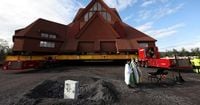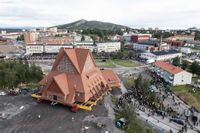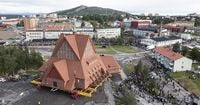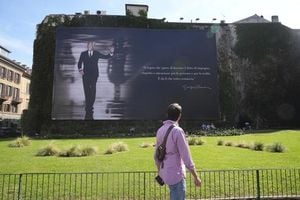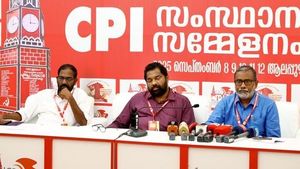In the far reaches of northern Sweden, where the Arctic Circle slices through the landscape and the midnight sun dazzles in summer, a remarkable event has captured the world’s attention: the slow-motion relocation of the beloved Kiruna Church. Over two chilly August days in 2025, this iconic wooden structure—painted a deep red and designed in the style of the Indigenous Sami people—was carefully moved three miles east, making way for the relentless advance of the world’s largest underground iron-ore mine.
The spectacle, dubbed “The Great Church Walk” by Swedish broadcaster SVT, was no ordinary building move. It was a feat of engineering, community spirit, and cultural reckoning, drawing thousands of spectators bundled in layers against the sub-10 degree Celsius winds. According to Associated Press, the church was lifted onto massive beams, hoisted onto a custom-built trolley, and inched along at a glacial pace—sometimes as slow as 0.5 kilometers per hour—over a specially widened road. The journey, lasting roughly 12 hours across two days, was punctuated by musical performances, a royal visit, and even a traditional Swedish fika coffee break.
The Kiruna Church, or Kiruna Kyrka as it’s known in Swedish, is no ordinary house of worship. Consecrated in 1912 atop a hill overlooking the town, it’s been called Sweden’s most beautiful building in a Ministry of Culture poll and stands as one of the country’s largest wooden structures. Its neo-Gothic lines and Sami-inspired details reflect the region’s unique cultural blend. Built as a gift from the state-owned mining company LKAB, the church has served generations of townsfolk and tourists alike, offering both spiritual solace and architectural wonder.
But Kiruna itself is a town in motion. Situated 200 kilometers above the Arctic Circle, it’s home to about 23,000 residents spread across the vast, snowy expanse of Swedish Lapland. The town owes its existence—and its upheaval—to the rich seams of iron ore beneath its feet. Since the mine opened in 1910, LKAB has extracted around two billion tonnes of ore, providing 80 percent of Europe’s supply. As the mine burrows deeper—now reaching depths of 1,365 meters—cracks have begun to appear in roads and buildings, threatening to swallow the town whole.
In response, Kiruna has embarked on one of the most ambitious urban relocation projects in modern history. The process, which began in 2004, aims to move thousands of people, homes, and public buildings—including the church—to a new city center safely away from the shifting ground. As of July 2025, 25 buildings had already made the journey, with 16, including the church, still to go. LKAB has widened roads, dismantled viaducts, and built hundreds of new homes, shops, and a city hall in the new downtown. According to local officials, the project is about halfway complete, with another decade of work ahead.
The church’s move was a carefully choreographed affair, attended by Swedish King Carl XVI Gustaf and featuring a performance by KAJ, Sweden’s 2025 Eurovision entry. Media from around the world descended on Kiruna, and SVT’s livestream of the event—titled “The Great Church Walk”—became a national sensation, echoing the broadcaster’s annual coverage of the moose migration. For many, it was a moment of awe and pride. British tourists Anita and Don Haymes, on their third visit to Kiruna, altered their plans just to witness the event. “It’s an amazing feat that they are doing,” Anita told AP. “It’ll be interesting to see it moving, unbelievable.”
For others, the move was bittersweet. Lena Tjarnberg, the church’s vicar, described the last service in the old location as a moment of mixed emotions. “The last day you go down the stairs and close the church door, you know it’s going to be several years before you can open it—and in a new place,” she told AP. “We don’t know how it’s going to feel to open the door.”
Yet, beneath the celebration, deeper tensions simmered. The expansion of the mine—and the city’s relocation—has profoundly affected the region’s Indigenous Sami community, who have herded reindeer across these lands for centuries. Lars-Marcus Kuhmunen, chairman of a local Sami reindeer herding organization, voiced his concerns to multiple outlets. “This area is traditional Sami land,” he explained, describing how the mine’s growth has already eaten into grazing grounds and threatened the migration routes vital to reindeer herding. “Fifty years ago, my great-grandfather said the mine is going to eat up our way of life, our reindeer herding. And he was right.”
The future, too, is uncertain. LKAB’s expansion isn’t stopping with iron ore; the company is now eyeing the Per Geijer deposit, which contains significant reserves of rare earth elements—metals essential for everything from smartphones to green technologies. The European Union has designated the project as strategic, hoping to reduce reliance on Chinese supplies. But for the Sami and environmental advocates, the promise of economic growth is weighed against the risk of further cultural and ecological disruption.
Despite the challenges, the move has become a symbol of resilience and adaptation. Mayor Mats Taaveniku called the church “a statement or a symbol for this city transformation.” As Kiruna’s new city center rises from the snow, the church’s journey stands as a testament to the town’s determination to survive—and even thrive—amid forces beyond its control.
For now, the church will remain closed to visitors, with plans to reopen at its new home at the end of 2026. As the dust settles and the beams are lowered, Kiruna’s people—old and new—will have a chance to reflect on what’s been lost, what’s been saved, and what lies ahead in the ever-shifting Arctic north.
